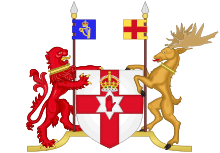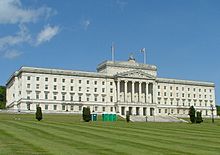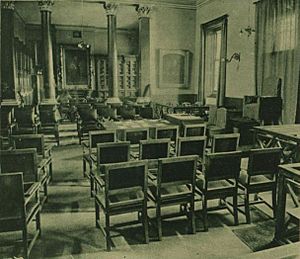House of Commons of Northern Ireland facts for kids
Quick facts for kids House of Commons of Northern Ireland |
|
|---|---|
| Devolved Parliament | |

Arms of Northern Ireland, 1924–1972
|
|
| Type | |
| Type | |
| History | |
| Established | 7 June 1921 |
| Disbanded | 30 March 1972 |
| Leadership | |
|
Ivan Neill (last)
|
|
|
Roderick O'Connor (last)
|
|
| Elections | |
| Single transferable vote (1921–1929) First-past-the-post (1929–1972) |
|
| Meeting place | |
 |
|
| Commons Chamber Parliament Buildings, Stormont, Belfast |
|
The House of Commons of Northern Ireland was an important part of the government in Northern Ireland. It was like the "lower house" of the Parliament of Northern Ireland. This parliament was created in 1920 by a law called the Government of Ireland Act 1920.
The other part of the parliament was called the Senate, which was the "upper house". The House of Commons of Northern Ireland stopped existing in 1972. This happened when a new law, the Northern Ireland Constitution Act 1973, was passed.
Contents
Who Were the Members?
The House of Commons had 52 members. Most of these members were elected from different areas, called constituencies. Until 1969, four members were chosen from students who had graduated from The Queen's University of Belfast.
In 1969, these university seats were removed. Instead, four new areas were created around Belfast to elect members. This was because Belfast's population had grown a lot.
What Did the House of Commons Do?
The House of Commons had several key jobs, similar to other parliaments that follow the Westminster System of government.
- Approving Money: It had to approve money for the government to spend. This is called "Supply."
- Supporting the Government: It decided if the government had enough support to stay in power.
- Choosing Leaders: Members of the government, including the Prime Minister of Northern Ireland, were chosen from the House of Commons. The Prime Minister was picked by the Governor of Northern Ireland.
How Were Members Elected?
The law that created Northern Ireland's government said that elections for the House of Commons had to use a system called Single Transferable Vote (STV). This system was first used in Ireland in 1919.
STV was chosen on purpose. It was meant to give a better chance for groups who were not in the majority to get elected. After three years, the Northern Ireland Parliament could change this election system.
Many people in the main governing party, the Ulster Unionist Party, did not like STV. They thought it was "un-British" because most of the United Kingdom used a different system called First Past the Post. When the Ulster Unionist Party lost eight seats in the second election, they decided to change the system. They switched to First Past the Post, which made it harder for smaller groups to win seats. However, STV was still used for the four university seats.
The Opposition Parties
Many people, both Unionists and Nationalists, were against the creation of Northern Ireland. Nationalists, in particular, felt left out of the new government.
The main Nationalist party, the Nationalist Party, often refused to take their seats in Parliament. They boycotted it completely until 1925. This meant that the main opposition party was often missing. This led to people saying that Northern Ireland was run by "one party."
For many years, some of the strongest opposition came from independent Unionist members. One famous example was Tommy Henderson. He was known for giving a very long speech in 1936 that lasted almost ten hours!
How Parliament Worked
The House of Commons in Northern Ireland tried to work just like the Parliament of the United Kingdom in Westminster. Each new session of Parliament began with a speech from the King or Queen. After 1922, the Speech from the Throne was given by the Governor of Northern Ireland.
The House of Commons had a chamber that looked like the British House of Commons. However, the seats and furniture were blue instead of green. Members would refer to each other as "the honourable Member for the (X) division."
To become a law, a bill had to go through several steps in both the House of Commons and the Senate. These steps included a First Reading, Second Reading, Committee Stage, and Third Reading.
Because the Northern Ireland Parliament was smaller, it had less work to do. This meant that sessions were often short, and working hours were not very long.
Where They Met
The very first meeting of the House of Commons happened in Belfast City Hall in June 1921. King George V gave a famous speech there. He asked for peace between Irish people and for Northern Ireland to treat everyone fairly.
For its first ten years, the Parliament met in the Presbyterian College. This was close to the City Hall. Meanwhile, new Parliament Buildings were being built in East Belfast, at a place called Stormont.
The building plans had to be made smaller because of money problems. The new Parliament Buildings were officially opened in 1932. The House of Commons and Senate chambers were built facing each other, just like in the British Parliament.
The End of the House of Commons
During the 1960s, Northern Ireland faced many problems. There were claims that the Unionist government was unfair. People also demanded more civil rights. This led to the start of a difficult period known as The Troubles.
In 1972, the British government decided to suspend the Northern Ireland Parliament and government. This was done using its legal powers. In 1973, the Parliament was completely abolished by the Northern Ireland Constitution Act 1973. The House of Commons last met on March 28, 1972.
Today, the Parliament Buildings at Stormont are used by the Northern Ireland Assembly. This Assembly is the new government body for Northern Ireland.
Images for kids



